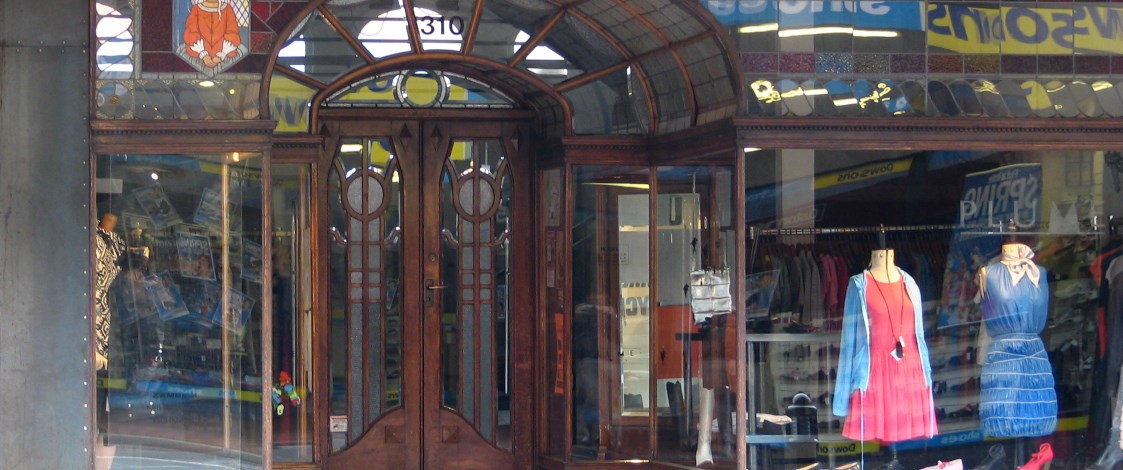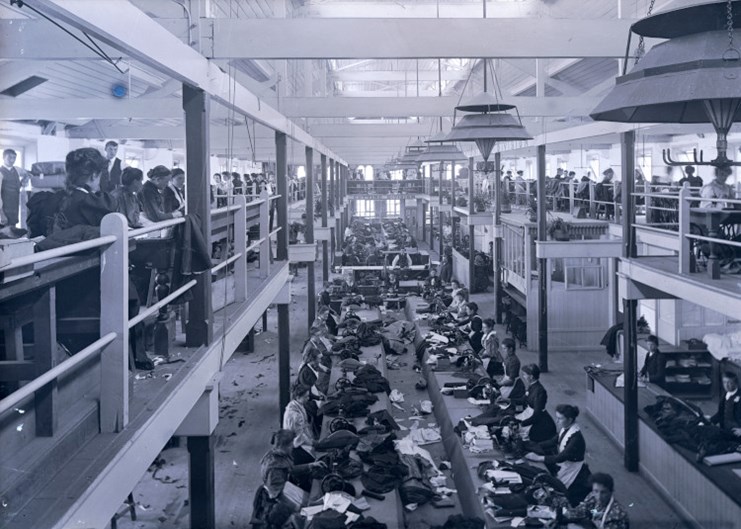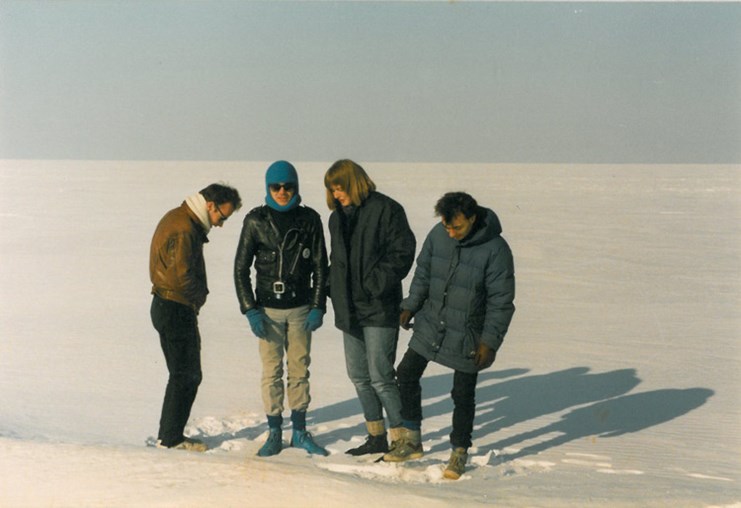Stories
Locating the Dunedin Fashion Identity
2015

At the Fashion Museum we adhere to the maxim, ‘we are what we wear’. We see that our clothes and adornment and how we use them provides a window through which we can view ourselves as New Zealanders, our history and our evolving identity. We have seen the truth of this manifest on a national level in our relationship to wearing the colour black and here we ask if there might also be a unique regional identity? Can we find evidence of a distinctive Auckland, Wellington, Christchurch or Dunedin identity?
If that distinction does exist, where is it located? What are the markers and salient features that would allow us to recognise it? While climate is a natural determinant of variation in style, are there other qualities that are specific to a particular location and geography that give a place its own architecture, cultural values, history and also perhaps its own characteristic fashion? Here we turn to Dunedin, as we did for the exhibition A Darker Eden: Fashion from Dunedin, and look at some of the contemporary fashion that originates there and consider the question - is there a unique Dunedin fashion identity?
In 1880 Dunedin was New Zealand's largest city and its most prosperous. Established in 1848 by members of the Free Church of Scotland and named for Dùn Èideann, the Scottish Gaelic name for Edinburgh, the founding fathers aspired to create a romantic Eden in the south and migrated there in their thousands. The discovery of gold in Otago in the 1860s provided a new influx of capital and population that fuelled Dunedin's growth. In the wave of new immigrants were Irish, Chinese, Italian, Lebanese, French, German and Jewish people and the city's expanding wealth was invested in erecting grand stone buildings in a romantic neo-Gothic style which gave tangible expression to the high value that was placed on education, religion and culture. Dunedin was home to New Zealand's first university established in 1869, the Otago Museum was built in 1877 and the Art Gallery in 1884 and all around the city grand churches were erected for all denominations.
Local invention and industry contributed to the region’s prosperity through such innovations as the pioneering of the successful frozen meat export business, the establishment of the first men's clothing manufacturing factory in the country by Bendix Hallenstein and his brothers, the creation of a wool processing industry which provided employment and income for hundreds, especially for women. All contributed to Dunedin's importance in the 19th century New Zealand.

Factory floor of Hallenstein Brothers, 1880s. Image courtesy of the Hocken Collections, Uare Taoka o Hākena University of Otago Te Whare Wānanga o Otago, P2014-014/1 002.
The 20th century was less kind to Dunedin and growth failed to match that of the other urban centres so that today it is the sixth largest city in New Zealand. It has reinvented itself as a heritage city, refurbishing its Victorian architecture and promoting its' historic academic credentials. It also continues to sustain and expand the cultural capital generated by such creative luminaries as Frances Hodgkins, Charles Brasch, Janet Frame and Colin McCahon through fellowships and awards. In the 1980s its modern creative mantel was worn most visibly by musicians from the Flying Nun label who were collectively acknowledged by their location and became known in New Zealand and beyond, as “the Dunedin Sound”. By the mid 1990s fashion had been added to the creative ranks that represented Dunedin's rich culture offering.

The Chills on tour in the 1980s. They were one of the bands collectively known as the Dunedin Sound. Image courtesy of Justin Harwood.
Just as the wider New Zealand fashion industry realised the commercial value of embracing and owning the “dark, edgy and intellectual” descriptors that were used by the international media to talk about our fashion when the New Zealand designers were seen on the world stage at the Sydney (1998) and London (1999) Fashion Weeks, so too has Dunedin's “dark Gothic” label become part of the mythology that serves the commercial branding of the local fashion industry. While this tag may signify a romantic idealism and an outsider ethos shared with the founding fathers of the city, one would be hard-pressed to reconcile all of the dispirit designers under this simplistic umbrella. Local distinction is more likely to be discovered in intangible ideas rather than in the tangible objects that result. It is more useful to look at commonalities rather than a unified “look” and to consider the local inflections and inspirations that the designers share and how these might serve to distinguish fashion from Dunedin.
In first instance of course we must note the obvious impact of geography and weather. Dunedin is located at just below 45° south and has a summer median temperature of 15°, a winter median of 6° and fickle sea-climate affected weather which come together to make it possible, and often desirable, to wear more than one layer of clothing for most of the year. Dunedin style, therefore, requires garments that can be closed to keep out the cold, that are made of wool and that can be worn with more clothes under and over them.

The weather has led to a Dunedin style of clothing designed to be layered to keep out the cold. This Carlson ensemble is made from antique chantilly lace with an under and overlayer of wool. Photo by Sarah Sisson, model Olivia Deaker, image courtesy of Carlson archives.
A second consideration is the ‘history’ effect. Living in an environment suffused with the past, surrounded by the mellow ageing of the city’s grand old stone buildings with their atmospheric charm, designers working in Dunedin breathe its history every day. Margarita Robertson of NOM*d has said that “there is no other city in New Zealand that can boast the history of Dunedin, its importance in early New Zealand and its underground feel. Its very free of pressures and influences that can often prove to be very superficial in other cities in New Zealand.”
Many seek to attribute Dunedin's non-conformity and “underground feel” to its geographic isolation, but I would emphasise instead an appreciation of the value of independence, modelled in first instance by the city's first European settlers, the members of the Free Church of Scotland. Independence and a singular vision that eschews prescriptive fashion trends are hallmarks of the practice of established Dunedin designers; Tanya Carlson in her pursuit of glamour, Donna Tulloch in her exploration of line and form and Margarita Robertson in her search for functionality and longevity.
Respect for the craft of making is a core value that has survived to distinguish contemporary fashion in Dunedin. Tanya Carlson expressed that appreciation when she said, “It's a true joy when you open something up and look inside and it's been so thoughtfully and beautifully made. Those little touches – a bound seam or a hand-covered dome. I'm very much into the craft and beauty of fashion. It’s a respect for women's work of the past.” Tanya is herself a consummate practitioner of the craft of cutting, draping and stitching often using vintage materials. Margarita Robertson's approach has been to revive and remake vintage garments, honouring the original maker by restoring the pieces to a new and useful life. Designers Mu and Company of Strangers pay tribute to the craft of couture by concentrating on developing innovative cutting to renew our relationship with classic orthodox garments like tops and dresses. Jessie Wong applies a sober utilitarian aesthetic and careful construction to the bags she designs for her Yu Mei brand with the intention that they stand the test of time. Many of the others such as Maaike, Mild Red, Duncan Chambers-Watson and NOM*d have been engaged by the local history that is associated with the wool and knitting industries, pursuing and mastering the skills necessary to make desirable modern knits.
Dunedin has a local history that is associated with the wool and knitting industries. NOM*d's New Kimono is cut from machine knitted wool from Dunedin, photo by Brad Hicks (image 1). Donna Tulloch's tail-coat is made from Pride of New Zealand tartan, photo by Alan Dove (image 2). Women working at machines in the Roslyn Woollen Mill, circa 1907.Image courtesy of Alexander Turnbull Library, MNZ-0704-1/4-F.
Mindful of the perils of an industry that is all about the new, designers like Justine Tindley and Fiona Clements and her alter ego Señorita AweSUMO are honouring the value in the materials of the fashion industry and mitigating wastefulness. Following in the practice modelled by NOM*d, they are breathing new life into discarded fabrics and old garments; recovering and remaking them for a new wearer today. This is perhaps a new appearance of stereotypical Scottish carefulness but it is also thoroughly prudent and mirrors the search of the founding fathers for a better future and features strongly as a motivating concern especially among the young designers who want to create local solutions to global problems of resource exploitation and waste.
Designers like Justine Tindley and Fiona Clements and her alter ego Señorita AweSUMO are following in the practice modelled by NOM*d, breathing new life into discarded fabrics and old garments. Nom D customised denim jacket (image 1 - NZFM), Metamorphosis ensemble designed by Justine Tindley (image 2 - NZFM) and Te Warewhare Whakapau' designed by Fiona Clements for her label Señorita AweSUMO (image 3 - NZFM)
Dunedin based designers and others who come from there or have completed their training in the city have all experienced life under the influence of Dunedin's history and they also bring their own personal history to their practice. The three most established designers; Margarita Robertson, Donna Tulloch and Tania Carlson have each created their own distinctive handwriting, developing a very personal creative identity that is mapped onto their location. The Dunedin inflection is also unmistakable in the life’s work of the so called Godmother of New Zealand fashion, Elizabeth Findlay.
The cohort that follows in their footsteps; Vaughan Geeson, Sara Munro, Charmaine Reveley, Abby van Schreven, Emilie Pullar, Anjali Stewart and Rachel Easting have all created brands that are defined by that foundational characteristic of independence and they steadfastly avoid fadism choosing instead to embrace the value in quality and durability. Students in the Otago Polytechnic fashion programme are encouraged to discover their personal style and fashion identity by pursuing self-awareness and reflexivity. With the various origins and landing places of the later graduates it will be revealing to see if they have also acquired some of the characteristics with which we are able to identify them as emerging from that Darker Eden, Dunedin.
Text by Doris de Pont. Banner image of Plume, 310 George Street, Dunedin.
Published October 2021.